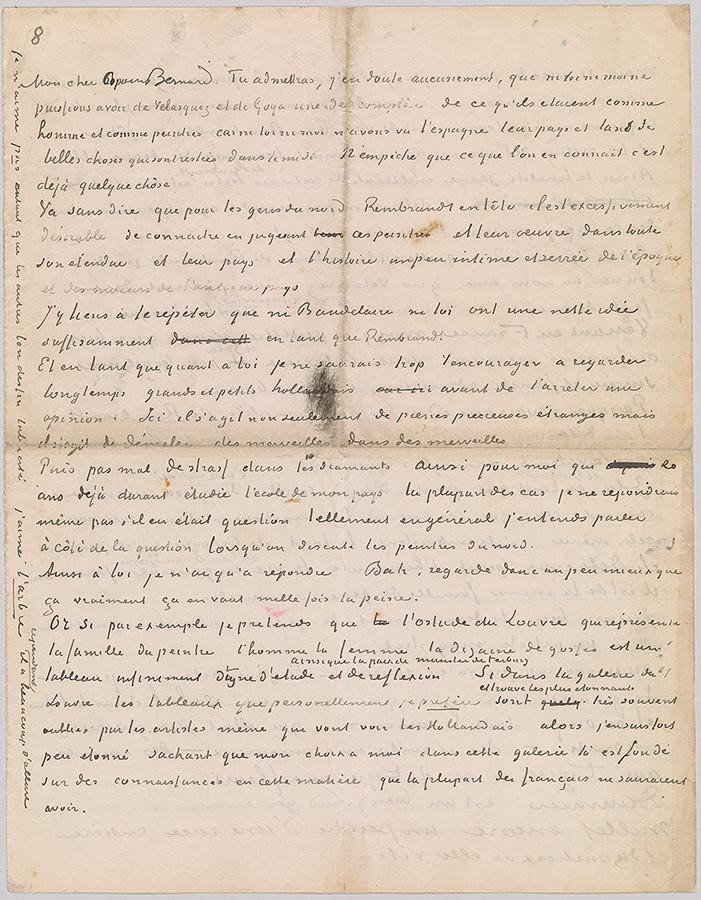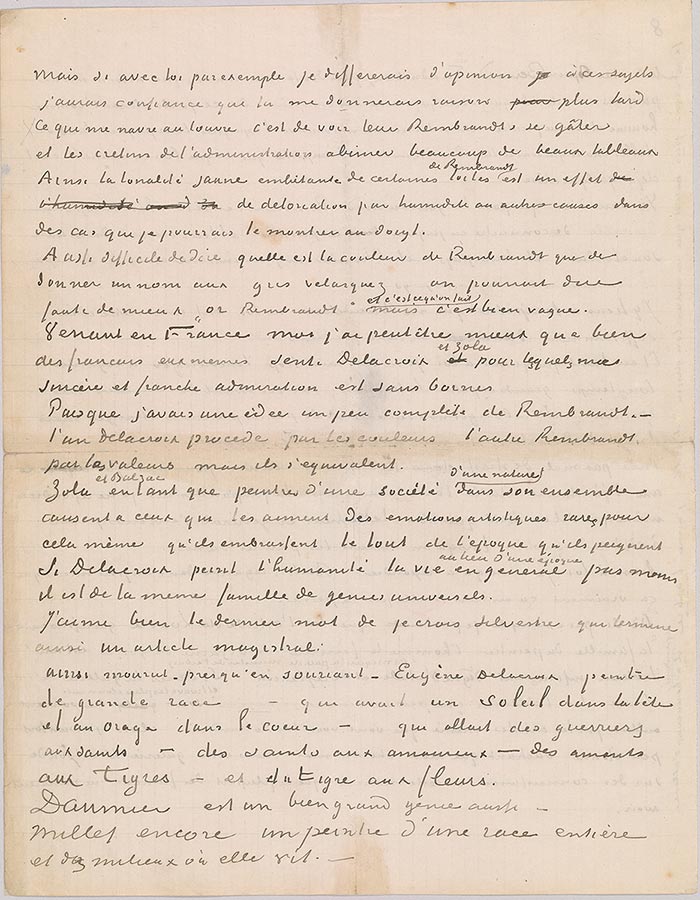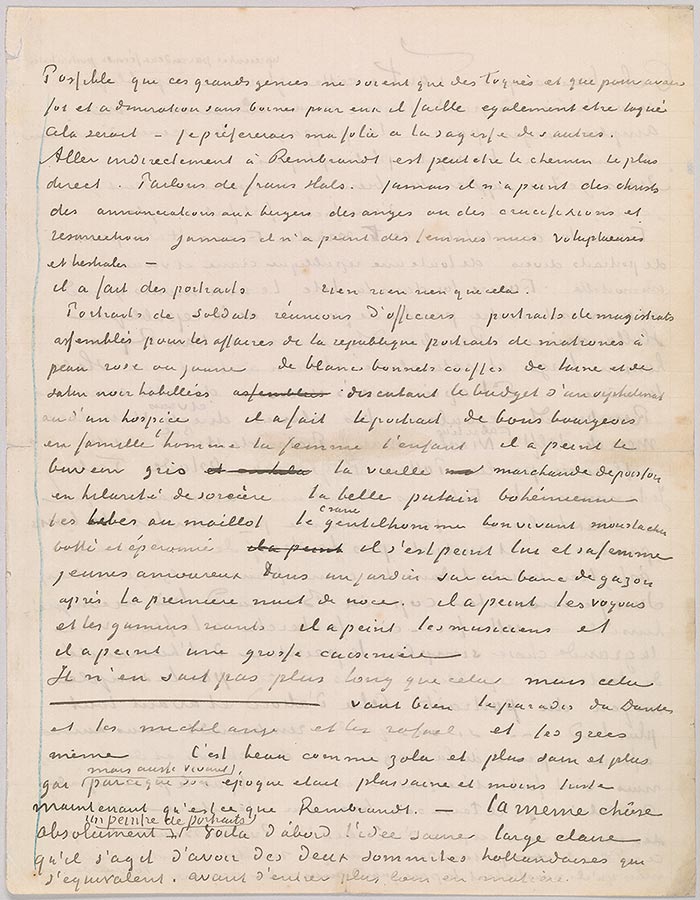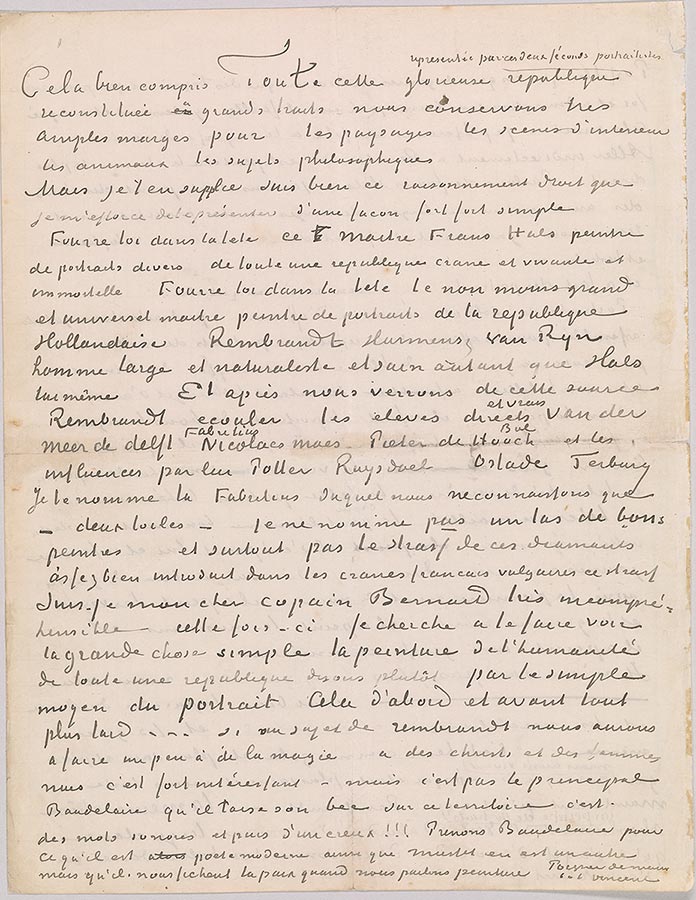Letter 13, page 1

Vincent van Gogh, letter to Émile Bernard, Arles, 30 July 1888, Letter 13, page 1
Thaw Collection, given in honor of Charles E. Pierce, Jr., 2007
My dear old Bernard.
You'll agree, I've no doubt at all, that neither you nor I can have a full idea of what Velázquez and
Goya were like as men and as painters, because neither you nor I have seen Spain, their country,
and so many fine things that have remained in the south. Even so, what we know of them does
count for something in itself.
It goes without saying that for the northerners, Rembrandt first and foremost, it is extremely
desirable, when judging these painters, to know both their work in its full extent and their country,
and the rather intimate and hidden history of those days, and of the customs of the ancient country.
I want to repeat to you that neither Baudelaire nor you has a sufficiently clear idea when it
comes to Rembrandt.
And when it comes to you, I could not encourage you enough to take a long look at major
and minor Dutchmen before arriving at an opinion. Here it's not just a matter of strange precious
stones, but it's a matter of sorting out marvels from among marvels.
And a fair amount of paste from among the diamonds. Thus for myself, having been studying
my country's school for twenty years now, in most cases I wouldn't even reply if the subject came
up, so much do I generally hear people talk beside the point when the painters of the north are
being discussed.
So to you I can only reply, come on, just look a little more closely than that; really, it's worth
the effort a thousand times over.
Now if, for example, I claim that the van Ostade in the Louvre, which shows the painter's family,
the man, the wife, the ten or so kids, is a painting infinitely deserving of study and thought,
just like ter Borch's Peace of Münster. If the paintings in the gallery in the Louvre that I personally
prefer and find the most astonishing are very often forgotten by the very artists who go to see the
Dutchmen, then I'm not in the least surprised, knowing that my own choice in that gallery is based
on a knowledge of this subject that most of the French could not have.
© 2007 Van Gogh Museum, Amsterdam
Letter 13, page 2

Vincent van Gogh, letter to Émile Bernard, Arles, 30 July 1888, Letter 13, page 2
Thaw Collection, given in honor of Charles E. Pierce, Jr., 2007
But if, for example, my opinion differed from yours on those subjects, I'm confident that you
would agree with me later. What grieves me at the Louvre is to see their Rembrandts getting spoiled
and the cretins in the administration damaging many beautiful paintings. Thus the annoying yellow
tonality of certain canvases by Rembrandt is an effect of deterioration through humidity or
other causes, instances of which I could point out to you.
As difficult to say what Rembrandt's color is as to give a name to the Velázquez grays; we could
say, for want of something better, "Rembrandt gold," and that's what we do, but that's quite vague.
Having come to France I have, perhaps better than many Frenchmen themselves, felt Delacroix
and Zola, for whom my sincere and frank admiration is boundless.
Since I had a fairly complete idea of Rembrandt. One, Delacroix, proceeds by way of colors,
the other, Rembrandt, by values, but they are on a par.
Zola and Balzac, as painters of a society, of reality as a whole, arouse rare artistic emotions in
those who love them, for the very reason that they embrace the whole epoch that they paint. When
Delacroix paints humanity, life in general instead of an epoch, he belongs to the same family of
universal geniuses all the same.
I love the closing words of Silvestre, I think it was, who ends a masterly article like this:
Thus died—almost smiling—Eugène Delacroix, a painter of high breeding—who had a sun
in his head and a thunderstorm in his heart—who went from warriors to saints—from saints to
lovers—from lovers to tigers—and from the tiger to flowers.
Daumier is also a really great genius.
Millet, another painter of an entire race and the settings in which it lives.
© 2007 Van Gogh Museum, Amsterdam
Letter 13, page 3

Vincent van Gogh, letter to Émile Bernard, Arles, 30 July 1888, Letter 13, page 3
Thaw Collection, given in honor of Charles E. Pierce, Jr., 2007
Possible that these great geniuses are no more than loonies, and that to have faith and boundless
admiration for them you'd have to be a loony too. That may well be—I would prefer my madness
to other people's wisdom.
To go to Rembrandt indirectly is perhaps the most direct route. Let's talk about Frans Hals.
Never did he paint Christs, annunciations to shepherds, angels or crucifixions and resurrections;
never did he paint voluptuous and bestial naked women.
He painted portraits; nothing nothing nothing but that.
Portraits of soldiers, gatherings of officers, portraits of magistrates assembled for the business
of the republic, portraits of matrons with pink or yellow skin, wearing white bonnets, dressed in
wool and black satin, discussing the budget of an orphanage or an almshouse; he did portraits of
good citizens with their families, the man, his wife, his child; he painted the sozzled drinker,
the old fishwife full of a witch's mirth, the beautiful gypsy whore, babies in swaddling clothes,
the gallant, bon vivant gentleman, mustachioed, booted and spurred; he painted himself and
his wife as young lovers on a turf bench in a garden, after their first wedding night. He painted
guttersnipes and laughing urchins, he painted musicians and he painted a fat cook.
He doesn't know much more than that, but it's———————well worth Dante's Paradise
and the Michelangelos and Raphaels and even the Greeks. It's beautiful like Zola, and healthier
and more cheerful, but just as alive, because his epoch was healthier and less sad. Now what is
Rembrandt? The same thing entirely—a painter of portraits. That's the healthy, broad, clear idea
that one must have first of all of the two eminent Dutchmen, who are on a par, before going into
the subject more deeply.
© 2007 Van Gogh Museum, Amsterdam
Letter 13, page 4

Vincent van Gogh, letter to Émile Bernard, Arles, 30 July 1888, Letter 13, page 4
Thaw Collection, given in honor of Charles E. Pierce, Jr., 2007
This fully understood, ALL this glorious republic, represented by these two prolific portraitists,
re-created in broad strokes, we retain very wide margins for landscapes, interior scenes, animals,
philosophical subjects.
But I beg you, carefully follow this straightforward argument, which I am doing my utmost to
present to you in a very very simple way.
Get him into your head, this Master Frans Hals, painter of various portraits of a whole selfassured
and lively and immortal republic. Get into your head the no less great and universal master
portrait painter of the Dutch republic, Rembrandt Harmensz. van Rijn, a broad and naturalistic
and healthy man, as much as Hals himself. And after that we'll see flowing from that source, Rembrandt,
the direct and true pupils, Vermeer of Delft, Fabritius, Nicolaas Maes, Pieter de Hooch, Bol;
and those influenced by him, Potter, Ruisdael, Ostade, ter Borch. I mention Fabritius to you there,
by whom we know only—two canvases—I don't mention a heap of good painters, and especially
not the paste of these diamonds, paste firmly embedded in ordinary French skulls.
Am I, my dear old Bernard, terribly incomprehensible this time? I'm trying to make you see
the great simple thing, the painting of humanity, let us rather say of a whole republic, through the
simple medium of the portrait. This first and foremost; later———if, on the subject of Rembrandt,
we're dealing to some extent with magic, with Christs and nude women, it's very interesting—but
it's not the main thing. Let Baudelaire hold his tongue in this department, they're resounding
words, and how hollow!!! Let's take Baudelaire for what he is, a modern poet just as Musset is
another, but let them leave us alone when we're talking painting.
Handshake.
Ever yours,
Vincent
I don't like your drawing Lubricity as much as the others; I like the tree, however, it has a great look.
© 2007 Van Gogh Museum, Amsterdam